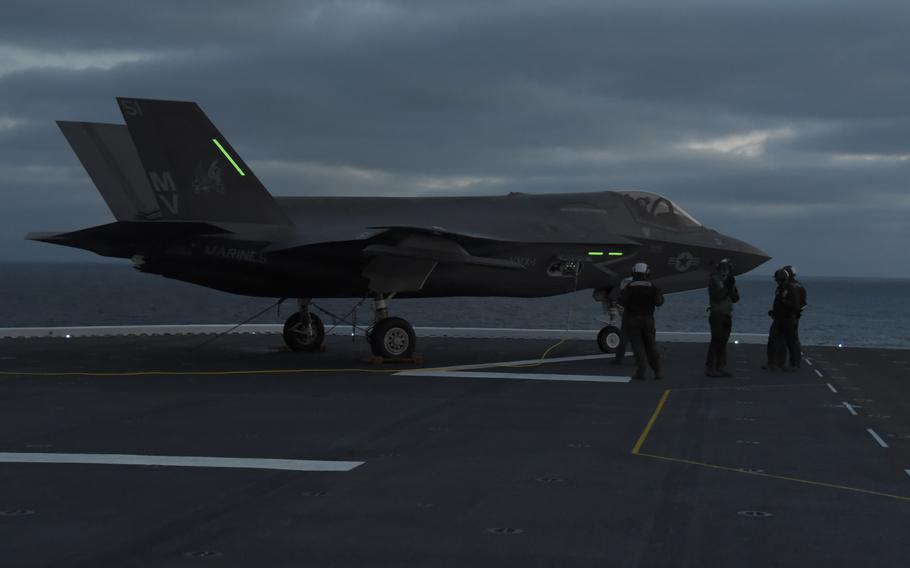
An F-35B Lightning II attached to Marine Operational Test and Evaluation Squadron (VMX) 1 idles on the flight deck of amphibious assault ship USS Tripoli (LHA 7) during night flight operations Jan. 19, 2024. (Peter Burghart/U.S. Navy)
U.S. taxpayers could be on the hook for millions of dollars in repairs if F-35 fighter jets suffer major weather damage while waiting on a Texas tarmac for a long-delayed software upgrade, according to the Pentagon’s contracts oversight agency.
The disclosure from the Defense Contract Management Agency is the latest twist in the saga of the Lockheed Martin Corp. fighter jet that’s already projected to cost more than $1.8 trillion over the course of its life cycle, including development, production and sustainment, making it the most expensive weapons system in history.
The “significant liability” stems from a standard clause in military aircraft contracts that limits Lockheed’s maximum cost for repairs or replacement to $100,000 per jet, according to the agency and the Government Accountability Office.
The Pentagon would be responsible for the rest, up to the full cost of replacing the jets, which were built at a price tag of $82.5 million to $109 million each depending on the model.
“This insurance works very similar to commercial auto and aircraft insurance,” the contract management agency said in a statement, disclosing the provision for the first time. “Provided the contractor meets the underwriting terms and conditions, then the U.S. will cover the costs over and above the deductible, with a few exceptions.”
None of the parked aircraft have been damaged so far, according to the Pentagon’s F-35 program office. But summer storms in Fort Worth can produce hail and winds up to 60 miles an hour, according to Jennifer Dunn, a National Weather Service meteorologist. Storms increase in severity in the fall, with hail, damaging winds, tornadoes and flooding more likely, she said.
“If the aircraft is a complete loss, then the U.S. would either cover the cost of a new aircraft or determine not to replace the lost aircraft,” the agency said. “Damage caused by tornado, hail and windstorm are covered; however, damage caused by a mechanic is determined on a case-by-case basis depending on the task being performed.”
Lockheed has delivered almost 1,000 of the jets, about a third of the potential total to be built, with about 650 for the U.S. military and the rest to allies including the UK, Norway, Belgium, the Netherlands, Israel, South Korea and Japan. Singapore announced earlier this year it will purchase additional F-35s. A Belgian Air Force F-35A flew for the first time in May.
The planes are there awaiting the TR-3 hardware and software upgrade, a program that has been dogged by delays and overruns that the government has also had to absorb. The first fully capable jets with the TR-3 upgrade were supposed to be delivered in July 2023, but the program has been plagued by problems with the new software and a new integrated core processor for combat missions. The TR-3 upgrade is now expected to cost more than double its original $718 million price tag.
Citing security concerns, Lockheed and the F-35 program won’t say how many aircraft are parked at a Lockheed facility in Fort Worth, Texas, or whether they’re inside or outside. But Representative Rob Wittman, the Virginia Republican who leads the House Armed Services Tactical Air and Land Forces panel, told reporters in mid-May that at least 100 aircraft would be on the tarmac by July.
In an earnings call in January, Lockheed officials indicated deliveries of 75 to 110 planes could commence this month.
“We maintain the highest level of security and protection of F-35 aircraft,” Lockheed said in a statement. “TR-3 test results to date support our expected time line of delivering the first TR-3 combat training-capable aircraft in the third quarter,” which begins July 1. In the meantime, Lockheed is running out of parking space and it will need “to develop a plan to accommodate more,” according to the GAO.
Representative Ken Calvert of California, chairman of the House defense appropriations subcommittee, joked in a recent interview that “you open a garage in Fort Worth and there’s an F-35 in there. They are parked everywhere.”
With assistance from Roxana Tiron.